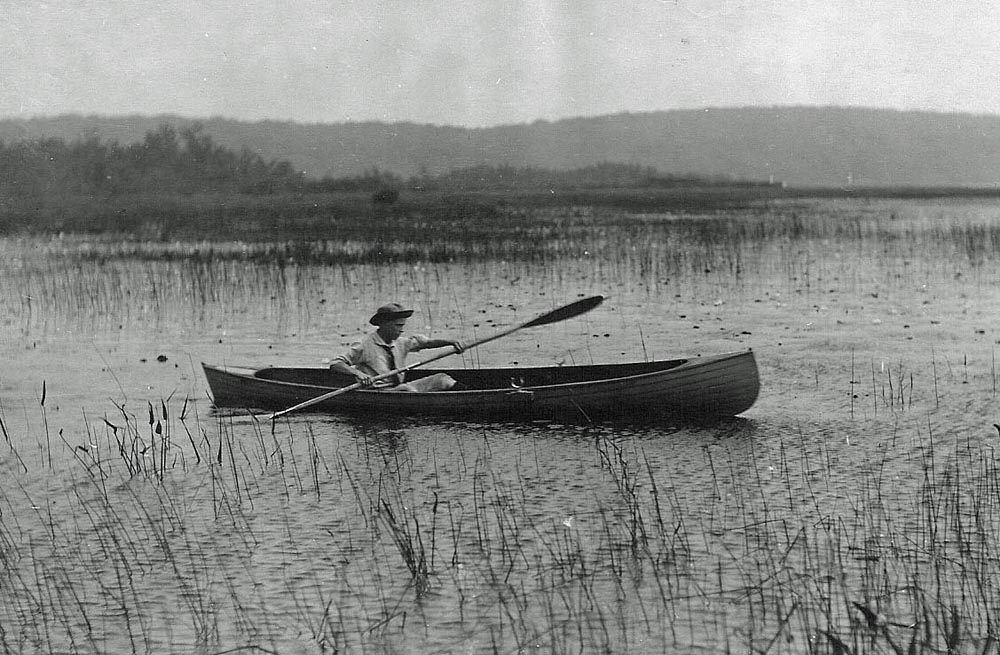True Tales: Take a Hike ~ Ponkapoag Pond
By George T. Comeau
A boy takes a canoe out onto Ponkapoag Pond in the early 1900s. (Courtesy of the Historical Society)
You can live in a place your whole life and still find surprise in your own backyard. Over the past year I have been exploring the Blue Hills Reservation. Trekking from Quincy to Canton and sometimes back again, the 7,000 acres of woodland and marsh is majestic and exhilarating. Some of the greatest views in Norfolk County can be seen from Buck Hill or high atop Hawk Hill. Most folks in Canton know Blue Hill, but there is so much more to discover. Trust me, a few hours in the Blue Hills Reservation and you will be transported to another time and place.
Last week, at a loss to find folks interested in coming along for yet another one of my tramps in the woods, I joined up with the Blue Hills Hiking Club. The mission: a night hike around Ponkapoag Pond. A moonlit Friday night set the stage in the 30-degree, star-studded auditorium of nature.
Ponkapoag Pond is the perfect place to spend an hour or two the next time you find yourself looking for “something to do.” Take a short drive to the intersection of Washington Street and Route 138, and pull right into the Ponkapoag Golf Course parking lot. You have now arrived at the Redman Farm. This land was once part of the Ponkapoag Plantation, comprising 6,000 acres dedicated exclusively for 60 natives — or about 12 families — so that they could live, worship, and keep the Sabbath under the watchful eyes of their English “guardians.” The Ponkapoag Praying Indian Town is a story for another day.
Suffice it to say, soon after the Ponkapoag Plantation was established, the English found ways to induce the native population into signing deeds for the fertile land into the hands of the very guardians appointed to protect them. Charles Redman obtained the first lease for approximately 100 acres from the Ponkapoag Indians in 1657, and soon thereafter his son Robert signed onto the lease and started the farm.
The land changed hands several times and in 1803 was purchased by Captain John Tucker. The large white farmhouse that currently stands at the entrance to the parking lot was built by Tucker and operated as a tavern. In 1823, Captain William Tucker purchased the property from his father and soon changed the name to the Ponkapoag Hotel.
Park your car near the golf clubhouse and you will see a gate with a street sign that reads Maple Avenue. While not an actual street, the then owner of the property, the Honorable Henry L. Pierce, built this pathway in 1869 to reach the pond. It was Pierce who made the most extensive renovations to the land and the property.
Henry Lillie Pierce was born in Stoughton in 1825, the son of Colonel Jesse Pierce and Elizabeth Vose Lillie. Pierce came from a long line of Colonial stock. His father had been an educator at Milton Academy and served as a state representative. In 1849, the family moved to the Lower Mills section of Dorchester. That same year, Pierce was hired to work as a clerk at the Baker Chocolate Company. Walter Baker, the owner of the chocolate company and stepbrother of Pierce’s mother, hired him on at a salary of $3 per week. Pierce then departed to work for a newspaper in the Midwest. The family, however, needed him to manage the growing chocolate business, and so he returned to Boston and was appointed manager of the Walter Baker Counting House in Boston. By 1854, Pierce was leasing the chocolate company from the Baker Estate and grew the business into one of the finest chocolate manufacturers in the world.
Amassing a large fortune, Pierce followed in his father’s footsteps and became a member of the Massachusetts House of Representatives. In 1870, after Dorchester became part of Boston, Pierce won election as the 22nd mayor of Boston. Then, in 1873, he was elected to the 43rd Congress and served two terms before serving a second term as Boston mayor in 1877. Redman Farm was Pierce’s playground opened to all his friends.
Pierce cultivated and managed 200 acres of the property. Jersey cows grazed luxuriously as if waiting for a Flemish painter to add them to the gentle landscape. One cow alone cost over $6,000, and the entire herd was valued at $40,000. The cultivation of hay on this farm surpassed many of the farms in the area, and the output was closely managed by a large staff on hand to serve the needs of Hizzoner…
Click here to read part 2 of George Comeau’s journey around Ponkapoag Pond.
Short URL: https://www.thecantoncitizen.com/?p=11703










